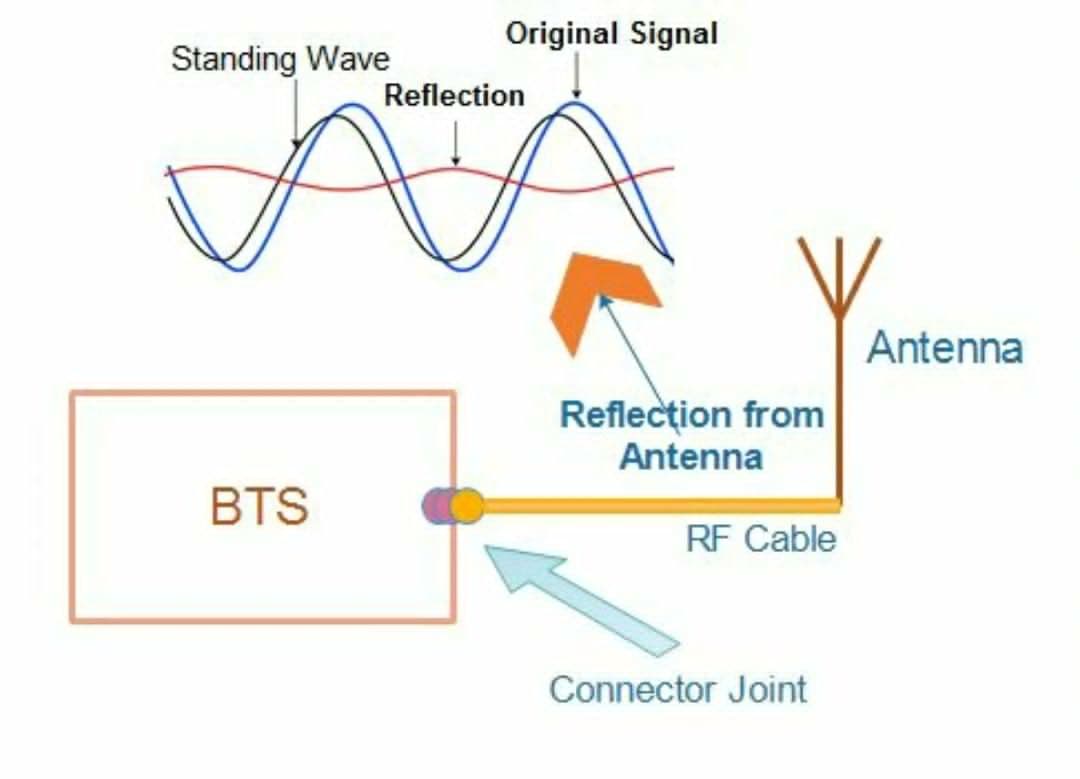Introduction
Everyone has heard at least. Many knows that a bad VSWR affects the performance of the Network. But what about you: do you know what it means, and why we need to know how to use these measures?
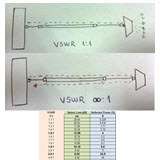
Today we’ll try to see a very simple way what is VSWR.
VSWR
To understand what is VSWR, we need to talk a little bit about signal propagation in radio frequency systems.
Simply put, the radio frequency signals are driven by electric cables between transmitters / receivers to their respective antennas.
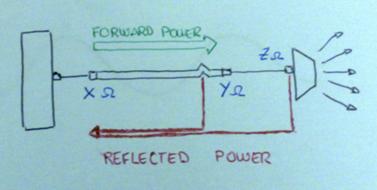
By its definition, VSWR or Voltage Standing Wave Ratio is a ratio of peak voltage on the minimum amplitude of voltage of standign wave. It does not help much, does it?
Okay, let’s try to see how it relates …
In radio frequency systems, the characteristic impedance is one of the most important factors to consider. In our case this factor is typically 50 Ohms. This is a constructive parameter, ie is some characteristic determined by its construction. In the case of a cable for example, depends on the size of the inner and outer conductors, and the type of insulation between them. All components of a link - cables, connectors, antennas - are constructed to have the same impedance.
When we insert an element in our system, we have what we call the Insertion Loss, which can be understood as something that is lost, taking into account what that actually went in and came out.
And this loss occurs in two ways - by Attenuation - especially on cable - and y Reflection.
As for the attenuation along the cables, there’s not much we can do. Part of the signal is lost along the cable by the generation of heat and also by unwanted radiated off the handle. This loss is characteristic of the same, and defined in terms of dB per lenght unit - the longer the cable is, the greater is the loss. This attenuation also increases with increasing temperature and frequency. Unfortunately, these factors are not much scope of our control, since the frequency is already preset by the system we use, and the temperature will be exposed to climatic variations of where the cable has to pass .
The most we can do is try to use cable with less attenuation , ie, cableswith high quality materials used in its construction of the drivers internal and external and insulating dielectric . As a rule, the larger the diameter of the cable, the lower your attenuation. Typical values of diameters are 1/2 “, 7/8” and 1 5/8 ".
The choice of coaxial cable for the system is a process that requires a very comprehensive analysis, taking into account its characteristics (is it softer, etc …) and costs of several options of existing cables, necessary cable length - and the consequent loss that it will introduce, the loading of the tower or brackets where cables will be posted, among others.
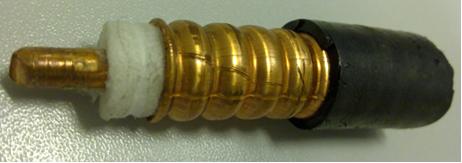
But the other form of loss that we have in our system, and can be controlled a bit more is the loss by reflection, ie loss of the signal, which has just returned, lost by the end where it was injected. For this reason we call the Return Loss.
If there is any problem in the middle between the transmitter / receiver and antennas - such as a fold or infiltration of water - half ends with the impedance mismatch. So, part of the signal which ideally should leave by the antenna, then returns reflected!
Speaking in terms of the matching impedances, if the value of X, Y and Z are equal, we have the following.
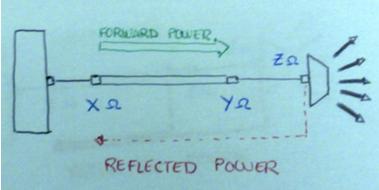
Now with values close to the real impedance unmatched scenario, have the following.
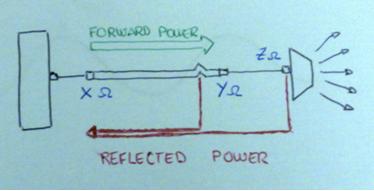
If we consider an ideal transmission line, the VSWR would be 1:1, ie all the power to reach your destination, with no reflection (nothing lost).
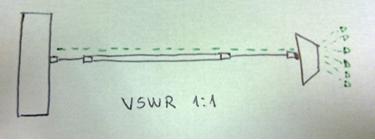
And the worst means of transmission in the world, we would have infinite VSWR, ie all the power would be reflected (lost).
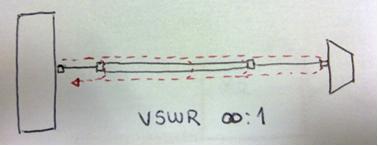
In Real World
Of course, there’s no “ideal system” nor the “worst case”, in real World. In real World what happens is that there are maximum VSWR that each application can accept.
The typical value in our case is 1.5:1.
So what are the problems that we can in a bad VSWR (very high)? Besides the power radiated effectively be much smaller than it should be, may also occur the burning of electronic components that have no protection for that unwanted reflected signal.
So as basic recommendations:
- Avoid bending the cables - making turns as smooth as possible - and tighten the connectors: isolating the system that does not suffer problems like water seepage or poeira.
- In addition, the connectors and cables must be made by professionals, and using professional equipment. It does not help tighten a connector evil feito.
- Use always the best quality components possible: no equipment is perfect, and even the processes of production glitches arise. The quality of the material and manufacturing process of the elements is paramount so as to achieve a better quality of sinal.
- Check that all elements of the system have the same impedance.
Tables and Graphs
Is not the goal here to explain what are the standing waves, because understanding requires significant wave theory, but a simple and very interesting for you to see - and understand - as these waves are formed is shown on the site bessernet.com. Be sure to visit the link below. Enter a value of return loss, hit enter, and check!
http://www.bessernet.com/Ereflecto/tutorialFrameset.htm
The magnitudes of reflection VSWR, Return Loss dB and Power Reflected% are related, and can be converted into one another, using the formulas or tables below.
For the standing wave (please visit link above to understand first):
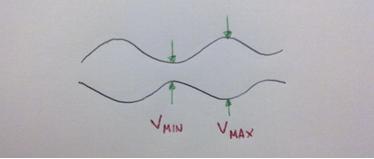

And for the power transmitted and reflected:
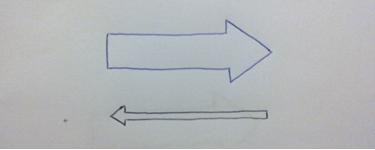

With some values we have tabulated the table below.
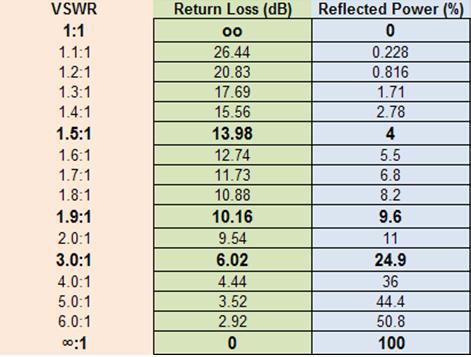
Here comes a good tip: Understand the return loss as 'How much weaker, in dB, the reflected unwanted signal is, compared with the transmitted signal? "
In the case of 1.5:1, power is 14 dB below the original value, or 4% was lost. Note that a VSWR of 1.9:1 almost 10% of energy is lost!
Conclusion
To conclude, we can then understand the VSWR as an indicator of signal reflected back to the transmitter radio frequency, always taking the value 1 in the denominator. And the lower this index, the better!
Thus, a radio frequency system with 1.4:1 VSWR is better than one with 1.5:1!
And another with 1:1 VSWR would have a perfect impedance matching. In other words, occurs only in theory.
Finally, the VSWR in a radio frequency system can be measured by special equipment.
One of them, and well known, is the Master Site.
With “Distance-To-Fault” mode you can identify the location of problems in a damaged system.
 Any documentation for above reference?
Any documentation for above reference?